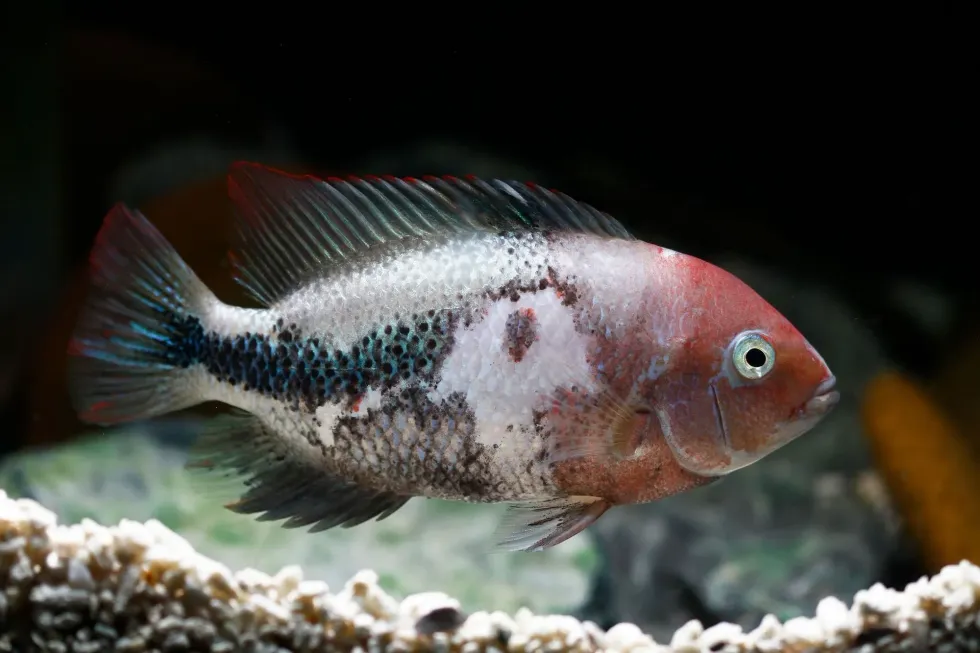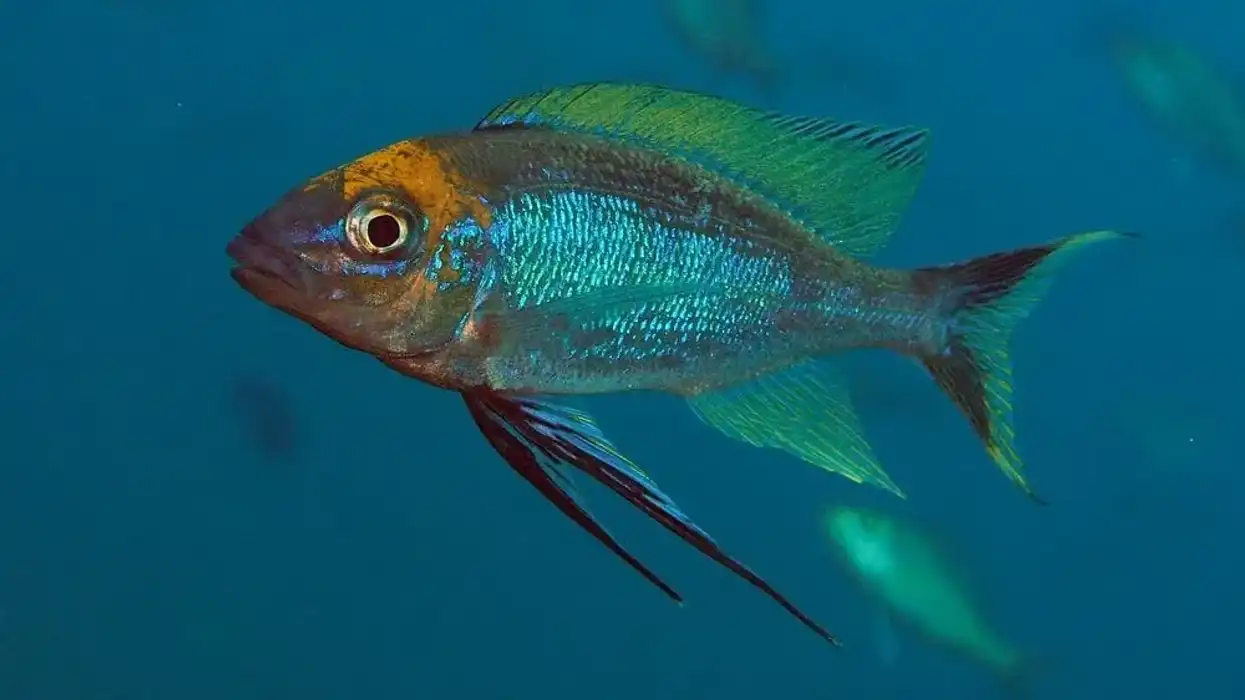The fenestratus cichlid (Vieja fenestratus) is a freshwater fish that is found in Central America in lakes. This fish species is suitable as a tank or aquarium fish. The Vieja fenestratus inhabit the rivers, streams, and lakes of the Central American region.
This is why they are also called the American cichlids. They are native to Lake Malawi of east Africa.
Apart from that, they can be seen in aquariums or as community tank fish across the globe. They are mostly solitary in nature. These fish are not highly territorial either.
Their temperament is not very aggressive, which is why they can not fight for their territory. Their diet consists of aquatic insects, invertebrates, plants and vegetable matter and even fenestratum.
The window cichlid can be found in two main color morphs commonly called grays or the pink morph. The coloration typically fades drastically to a paler pink to form a peachy white color. This color then reveals a distinctive black and white pattern with a bright red-tipped fin.
Keep on reading to learn more interesting facts about fenestratus cichlid. For more relatable content, check out these rainbow cichlid facts and convict cichlid facts for kids.
Fenestratus Cichlid Interesting Facts
What type of animal is a fenestratus cichlid?
The fenestratus cichlid (Vieja fenestratus) is a freshwater fish that is found in Central America in lakes. This fish species is suitable as a tank or aquarium fish. They are one of the more popular cichlids found in the Central American river regions.
What class of animal does a fenestratus cichlid belong to?
The Vieja fenestratus is tropical fish that belongs to the class of Actinopterygii and the family Cichlidae. Actinopterygii class of fish are those that are ray-finned and all types of cichlids fall under this class.
How many fenestratus cichlids are there in the world?
There is no substantial data that is available to give us an accurate number of Vieja fenestratus that are present in the world today. However, this freshwater species of cichlids are famous all over the world as tank and aquarium fish. These cichlids are also found in abundance in the freshwater Central American river region.
Where does a fenestratus cichlid live?
The Vieja fenestratus inhabit the rivers, streams, and lakes of the Central American region, which is why they are also called the American cichlids. They are native to Lake Malawi of east Africa.
Apart from that, they can be seen in aquariums or as community tank fish across the globe. These cichlids are quite popular in the United States and have also been exported to various other countries.
What is a fenestratus cichlid's habitat?
The habitat of the window cichlid primarily consists of warm and tropical river water where the temperature is moderate. These fish mainly inhabit streams and lakes of the Central American region.
The substrate of this fish is ideally in between the middle and the bottom layers of the water, be it a river, an aquarium, or a tank. When this species is kept in aquariums or tanks, the environment has to be large and should be filled with fenestratum and rocks that can replicate gravel.
This species is seldom found in groups or schools. They are mostly solitary in nature. These fish are not highly territorial either.
Their temperament is not very aggressive, which is why they can not fight for their territory. Their diet consists of aquatic insects, invertebrates, plants and vegetable matter and even fenestratum.
Who do fenestratus cichlid live with?
The window cichlid are non-schooling fish, which means they do not live in groups or with their faimilies. These fish are solitary in nature and are often found living on their own and swimming around alone.
How long does a fenestratus cichlid live?
The window cichlid has an average life span of eight years in the wild. These fish may live for a year longer if kept in an aquarium or tank and provided with the right type of food that suits their diet.
How do they reproduce?
Spawning and breeding are an important part of the window cichlid life cycle. Before spawning, the adult male and female fish will begin cleaning a potential spawning site.
The spawning site is usually flat rocks. At this time, their pink coloration will fade drastically to a paler pink to form a peachy white color.
This color then reveals a distinctive black and white pattern with bright red-tipped fin. Females lay over 1,000 eggs.
These eggs will then be fertilized and watched over by the male and female. These eggs hatch within 48-72 hours. Once again the female and male will protect the young and provide them food.
A week after the eggs have hatched, the baby fish will swim free. Adult males and females of this species will regularly carry out the breeding process.
The eggs are laid and hatched in large numbers. Therefore, it is important to have a steady plan in place for hundreds of juvenile fish as they can take over your aquarium and tank pretty quickly.
However, breeding this fish in tank water or an aquarium can be tricky, which is why breeding shouldn't be forced. Instead, an adequately large tank size should be provided and six adult individuals of varying sexes should be introduced into the tank or aquarium to get the fish to start breeding.
What is their conservation status?
The window fish is found in abundance in the wild and popular all over the world as aquarium tank mates and as a community fish, this species population is in no danger of going down at present.
As per scientific research done by the International Union For Conservation Of Nature or the IUCN, this fish species is currently categorized as a Least Concern species.
Fenestratus Cichlid Fun Facts
What do fenestratus cichlid look like?
The window cichlid can be found in two main color morphs commonly called grays or the pink morph. The coloration typically fades drastically to a paler pink to form a peachy white color.
This color then reveals a distinctive black and white pattern with a bright red-tipped fin, nearly resembling a window. This species is not aggressive in nature, they are a rather calm and shy fish. The male and female sexes of this fish look exactly the same, hence it is quite hard to distinguish between the two.
*We've been unable to source an image of a fenestratus cichlid and have used an image of pink cichlid instead. If you are able to provide us with a royalty-free image of a fenestratus cichlid, we would be happy to credit you. Please contact us at hello@kidadl.com
How cute are they?
The American cichlids have beautiful coloration and an adorable appearance. These fish are as calm and composed as they look. They are one of the most popular tank fish.
How do they communicate?
No significant research has been done to determine the form of communication that this species uses. These fish are solitary in nature and prefer living alone. One form of communication that has been observed at their breeding site is that these cichlids change their color patterns on their body.
How big is a fenestratus cichlid?
This species is a small species and measures only about 5.9 in (15 cm). They are slightly smaller than the firemouth cichlid and in a similar range as peacock cichlid.
How fast can a fenestratus cichlid swim?
There is no substantial data that is available to give us the exact speed of this species. However, they can be seen swimming slowly in their substrate where the temperature is low and suitable. This is why we can easily assume that they are fish who swim at a leisurely pace.
How much does a fenestratus cichlid weigh?
This fish is a small-sized fish which is why it weighs only 3.5 oz (0.1 kg). They are smaller than Texas cichlids.
What are the male and female names of the species?
The Vieja fenestratus do not have any distinct male and female names for their kind.
What would you call a baby fenestratus cichlid?
The baby fenestratus cichlid is simply known as fry. The fry has a high rate of growth and can consume food like plants and vegetable matter and even fenestratum as part of their diet.
What do they eat?
The diet of this fish primarily consists of aquatic insects, invertebrates, plants, fenestratum, and vegetable matter.
Are they dangerous?
This fish is known for its calm and non- aggressive temperament. They can not harm humans in anyway.
Would they make a good pet?
This fish would make an excellent pet and are generally suitable for an aquarium or a tank. They are quite cheap to get as well with one cichlid costing around $9. A cichlid is easy to care for. It only requires a large environment with suitable aquatic plants.
Did you know...
The window cichlid name is inspired by its prominent markings that give the appearance of windows; in fact, the Latin word for window is fenestratus. Hence, the Latin name was given to this fish.
What kind of fish is fenestratus cichlid?
The fenestratus cichlid is a freshwater tropical fish.
Is fenestratus cichlid aggressive?
This fish is known for its calm and non aggressive temperament.
Here at Kidadl, we have carefully created lots of interesting family-friendly animal facts for everyone to discover! For more relatable content, check out these stingray fun facts and chum salmon facts pages.
You can even occupy yourself at home by coloring in one of our free printable firemouth cichlid coloring pages.









